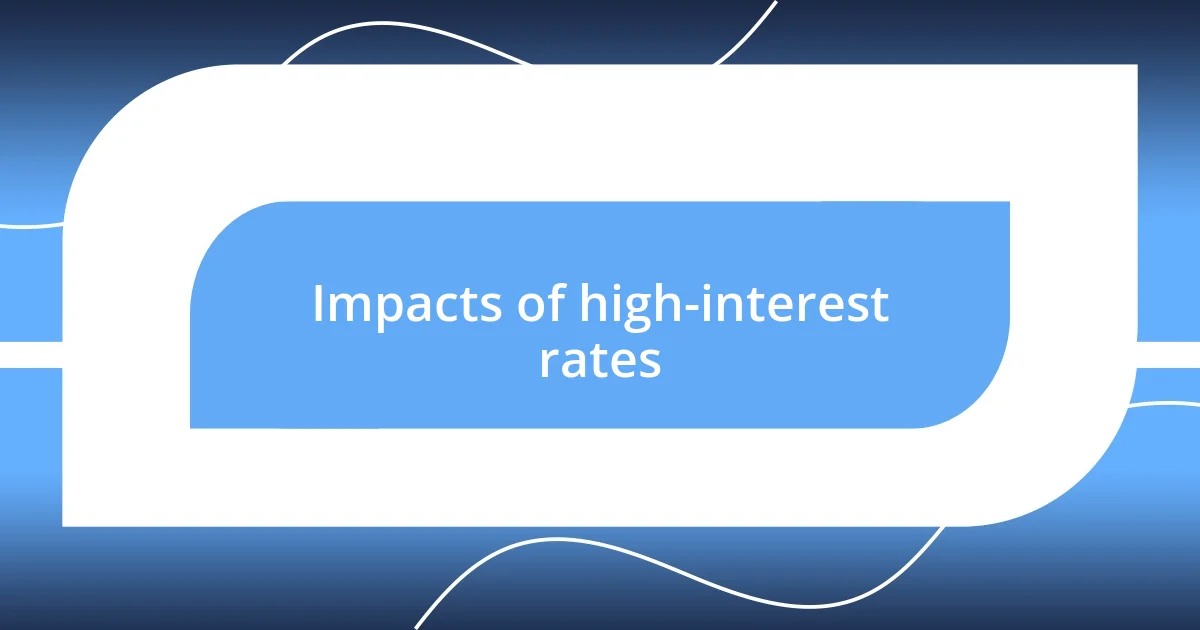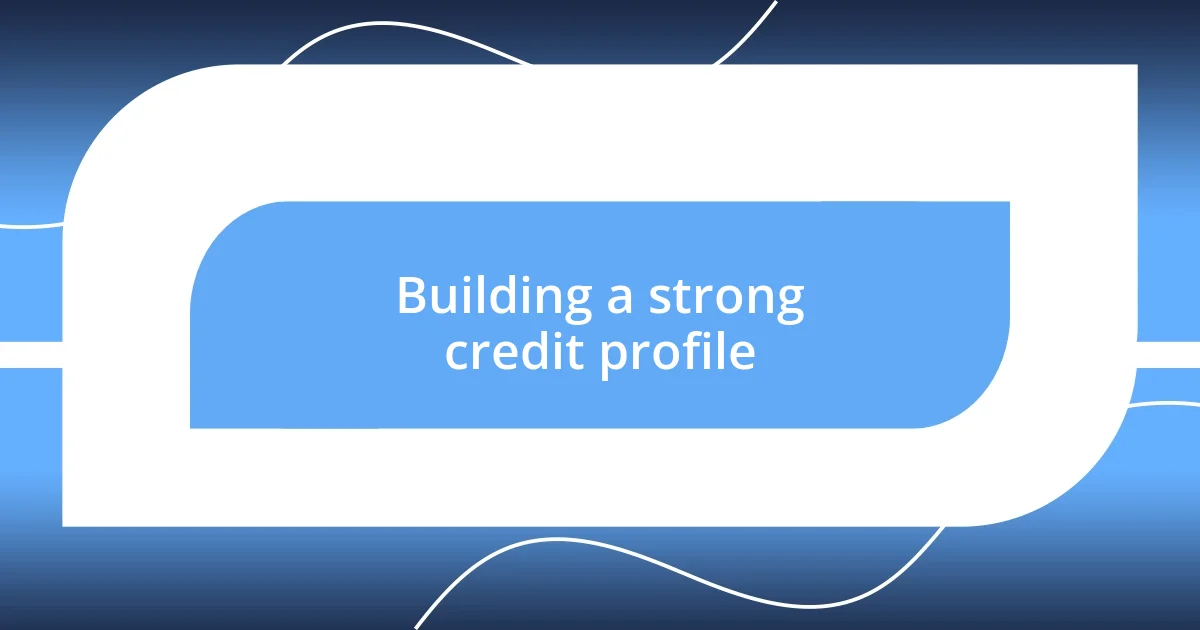Key takeaways:
- High-interest rates greatly affect personal finance decisions, influencing loan affordability, savings returns, and overall budgeting strategies.
- Refinancing loans, negotiating with lenders, and maintaining a strong credit profile are essential strategies for reducing interest costs and improving financial health.
- Establishing an emergency fund, regularly reviewing budgets, and investing for the long-term are crucial for effective financial planning and building wealth.

Understanding high-interest rates
High-interest rates can feel like a heavy weight on your financial journey, and I’ll never forget the moment I realized just how much they can impact my budgeting. I was looking to take out a loan for a car, and the difference in interest rates offered by different lenders shocked me. It wasn’t just about the monthly payment; it was about the total cost over time. Have you ever wondered how a seemingly small percentage difference could lead to thousands of dollars more paid in interest?
Interest rates are influenced by a myriad of factors, including inflation, the economy, and central bank policies. When the Federal Reserve raises rates to curb inflation, it can significantly affect consumer loans and credit cards. I remember feeling frustrated when my credit card interest rate rose suddenly; it made me rethink my spending habits. Have you experienced that moment when you realize your spending isn’t worth the extra cost in interest? It’s a wake-up call that pushes you to take a closer look at your financial choices.
Understanding high-interest rates isn’t just about numbers—it’s about recognizing how they fit into your broader financial picture. They can dictate whether saving is worth it or if a loan is feasible. I’ve had to make tough choices based on these rates, and honestly, it sometimes felt like a tightrope walk between desire and practicality. Does the thought of navigating this financial landscape seem daunting to you? It’s a complex but crucial part of managing one’s finances successfully.

Impacts of high-interest rates
High-interest rates can ripple through various aspects of personal finance, influencing everything from mortgage payments to credit card debt. I remember when I was ready to buy my first home; the prevailing interest rates made my excitement turn into anxiety. My monthly payment calculations shifted dramatically, and I found myself wondering if I could really afford my dream space. This experience made me see how high rates could potentially crush dreams or push them further away.
Moreover, the effects extend beyond just loans. High-interest rates can curtail consumer spending, which is something I noticed during a recent shopping trip. I hesitated buying a new laptop simply because I didn’t want to add more to my existing credit card balance, which had risen sharply due to high-interest fees. The emotional weight of prioritizing essential purchases over luxuries can become overwhelming. Have you felt that tug-of-war between your wants and financial realities?
Finally, there’s the impact on savings. When I learned that high-interest rates can lead to better returns on savings accounts, I initially felt hopeful. Yet, that hope was short-lived as I saw inflation simultaneously eating away at those gains. It’s a bittersweet scenario where the numbers don’t always tell the whole story. Navigating this complex relationship requires not just knowledge but a keen emotional awareness of one’s financial health.
| Impacts | Examples |
|---|---|
| Housing Market | Higher monthly mortgage payments can lead to less affordability for homebuyers. |
| Consumer Spending | Increased hesitance to spend on non-essentials due to rising debt costs. |
| Savings Returns | Inflation can diminish the benefits of higher interest on savings accounts. |

Strategies to reduce interest costs
One key strategy I’ve found to reduce interest costs is refinancing. When I realized that my mortgage rate was higher than the current market rate, I took the plunge to refinance. It felt a bit like diving into the deep end, but it really paid off. Lowering my rate meant smaller monthly payments and a significant reduction in the amount I’d pay over the life of the loan. If you haven’t looked at your current loans recently, you might be surprised at how much you could save with a little research.
- Negotiate with lenders: Don’t hesitate to ask for a better deal; you might be pleasantly surprised.
- Pay more than the minimum: During my college years, I made it a habit to pay a little extra on my credit card bills. Those small sacrifices added up over time, reducing the principal and ultimately the interest.
- Consider a balance transfer: I once moved my credit card balance to a card with a lower interest rate. It allowed me to focus on paying down the debt without the crushing weight of high-interest fees.
- Build up an emergency fund: The peace of mind I gained from having a small savings cushion helped me avoid relying on credit when unexpected expenses popped up.
Additionally, staying on top of your credit score can also make a significant difference. I learned firsthand that a few extra points could qualify me for better rates. When my score improved, it felt like I had unlocked a new level in my financial game, allowing me to secure lower interest rates on future loans. It’s a reminder that proactive financial habits lead to tangible rewards.

Choosing the right loan options
Choosing the right loan options can feel overwhelming, especially with high-interest rates lurking. I remember sitting at my kitchen table, spreadsheets scattered around me, researching different loan types. I found that fixed-rate mortgages offered stability that made me feel secure, while adjustable-rate mortgages – with their initially lower rates – gave me pause. Were those tempting rates worth the risk of future fluctuations? For me, the peace of mind that came with a fixed rate was worth the extra cost.
When considering loans, I quickly learned to evaluate the overall costs beyond just the interest rate. For instance, I qualified for a personal loan that boasted a lower rate, but once I examined the fees, it didn’t seem so attractive. I’ve had situations where the seeming savings were swallowed by origination fees. Has that ever happened to you? That experience taught me to go deep into the fine print and always ask questions – there’s no such thing as a silly question when it comes to your finances.
Ultimately, seeking terms that align with my financial goals became crucial. I recall discussing my options with a trusted friend who had previously navigated similar waters. Their insights on choosing loans with shorter repayment periods energized my perspective. Could I manage a tighter budget if it meant being debt-free sooner? The thought felt empowering and motivated me to reassess what I truly wanted from borrowing.

Refinancing your existing loans
Refinancing your existing loans can be a game changer, and I’ve seen this firsthand. When I decided to refinance my car loan, I was astonished by how much I could reduce my monthly payments just by shopping around for better rates. It felt great to finally free up some cash each month – it was almost like a little victory that gave me more flexibility in my budget.
I’ve learned that timing can also be crucial in the refinancing process. For instance, I previously hesitated to refinance my student loan because I feared the paperwork involved. However, after months of high payments, I finally took the plunge. The moment I saw the lower interest rate reflected in my new payments, it felt like lifting a weight off my shoulders. Isn’t it amazing how a few documents can lead to such profound relief?
Another insight I’ve gained is the importance of understanding the terms associated with refinancing. While I was excited about my new lower rate, I initially overlooked the potential fees involved. I remember getting a nasty surprise when I found out about closing costs. That experience taught me to weigh the benefits against the fees carefully. Have you ever experienced a similar situation? Ensuring that you’re not just chasing the allure of lower payments, but truly saving money in the long run, is vital.

Building a strong credit profile
Building a strong credit profile is essential for navigating high-interest rates successfully. I still vividly remember the moment I checked my credit score for the first time. It was an eye-opener—not because of the number, but because of what I realized I needed to improve. I started by keeping my credit utilization below 30%. This meant I could use my credit wisely while enhancing my score simultaneously. Have you ever thought about how your spending habits affect your credit? For me, it was a crucial shift that opened many doors.
One of the most impactful steps I took to build a solid credit profile was making timely payments. It seemed simple, but life can get in the way. I had a moment when I overlooked a small utility bill, and I could feel the weight of that mistake when I checked my score a few months later. I quickly signed up for automatic payments to ensure I never missed a due date again. It’s amazing how such a small change can have a big impact. Have you found a system that works for you in managing payments?
Lastly, I realized the importance of monitoring my credit report regularly. I started using a free service that gave me updates and alerts when there were changes. You wouldn’t believe the ease I felt knowing I had visibility into my credit activities. It allowed me to catch inaccuracies and address them before they could affect my financial standing. Have you ever reviewed your credit report and found something unexpected? It’s an empowering practice that can prevent bigger issues down the road.

Long-term financial planning tips
One key long-term financial planning tip I’ve found invaluable is setting up an emergency fund. I made it a priority to stash away three to six months’ worth of expenses, and I can’t stress enough how comforting that cushion has been. When my car unexpectedly broke down last year, having that fund saved me from spiraling into debt. Have you ever had a financial surprise that left you scrambling? An emergency fund can give you that peace of mind.
Another strategy that’s served me well is regularly reviewing and adjusting my budget. Initially, I created a budget that worked for me, but I didn’t revisit it often enough. It wasn’t until I noticed the little subscription services eating away at my savings that I realized the importance of staying proactive. Scheduling a monthly budget check-in has turned into a bit of an event for me; I grab my favorite coffee and sit down to see where my money’s going. How often do you look at your finances?
Lastly, investing for the long-term can be a game changer in building wealth. When I first dipped my toes into investing, I was overwhelmed, but I started small by putting money into an index fund. The steady growth over time has taught me the power of compounding interest. Have you considered how starting early can lead to significant gains later? I still remember the satisfaction I felt watching that little nest egg grow, reinforcing my decision to stick with it despite market fluctuations.














